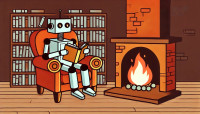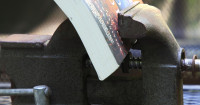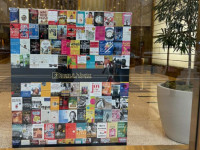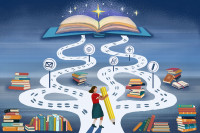The Dangers of AI for Writers and How to Use It Wisely
authorlink.com – Saturday October 19, 2024
If you’re a writer still vexed using Artificial Intelligence (AI) in your work, you are not alone. NPR reports that a recent Authors Guild survey found only 13% of writers admitted using AI for activities like brainstorming character ideas and creating outlines. In reality, anyone using the Internet to perform the simplest tasks is actually dancing with AI–consciously or unconsciously.
Whether you are paying a bill, traveling to a new location, or writing the next bestseller, you are interacting with AI. These special algorithms are embedded in every program and device we use, from simple spell-checkers to graphics generation.
And the technology is not going away.
So the question is, how are we writers going to grapple with this monster?
Writers are actually in a powerful position. We are the very ones who can shape whether technology will help or harm us.

Verse & Vision: Interview with Mark Gottlieb, Leading Literary Agent
v13.net – Saturday September 21, 2024

Literary agent Mark Gottlieb shares the secrets behind the success of bestselling authors, the challenges of today’s publishing landscape, and why trust, communication, and a shared vision are the keys to a thriving author-agent relationship.
Welcome back to “Verse & Vision,” the latest installment in our ongoing series, where we explore the multifaceted world of writing and publishing (check out the last instalment in case you missed it).
Today, I am thrilled to introduce you to our latest interview. Mark Owen Gottlieb is the vice president and distinguished literary agent at Trident Media Group, known for securing high-profile deals and representing numerous New York Times bestselling and award-winning authors. With experience in negotiating film and TV adaptations and a background in audiobook management and foreign rights from Penguin Books, Mark is dedicated to expanding his roster of talented writers. A graduate of Emerson College, he was a founding member and president of the Undergraduate Students for Publishing Club and established the Wilde Press. Mark has also lectured at prestigious institutions, including Yale, Cambridge, and Columbia.
What inspired you to become a literary agent?
Mark Gottlieb: “My inspiration to become a literary agent at Trident Media Group stems from my lifelong passion for books and storytelling. Growing up in a family deeply involved in the publishing industry, I was exposed to the world of literature from an early age. This, combined with my experiences at Emerson College and founding the Wilde Press at the college, ignited a desire to help talented writers bring their works to a wider audience. The opportunity to discover new voices, nurture creativity, and shape the literary landscape is what inspired me to pursue this career path.”

How We Find and Develop Writers
bbc.co.uk – Thursday September 19, 2024

The Head of New Writing for BBC Drama Commissioning and BBC Writers explains our team's work to develop talented storytellers for television.
There is a constant hunger for brilliant, original stories and storytellers at the BBC and for that reason the team here at BBC Writers are dedicated to finding, nurturing and uplifting writers at every stage of their careers. We endeavour to make BBC Writersroom a home for writers where individuals can learn, share, experiment with their craft and take risks in a supportive environment. We’re unique in the industry in that we’re a dedicated team of 15 individuals based out of five BBC hubs across the UK, solely committed to finding and championing writers. Our goal is to be an approachable open door to the BBC, and we strive to create a democratic, safe and inspiring space for writers. We want to encourage writers to feel empowered to tell the stories they want to tell and for their craft to be nurtured to its fullest potential.
BBC Writers is an integral part of the BBC Drama Commissioning team and has a direct link to the many exciting opportunities this presents for writers. Our Drama Commissioning colleagues are committed to working with the broadest range of storytellers from backgrounds and experiences that represent modern life across the whole of the UK. And so, we work closely to introduce them to some of the most exciting emerging voices that we identify during the course of our work.

Why NaNoWriMo supports AI for use in writing in some cases
venturebeat.com – Tuesday September 3, 2024

The organization’s official statement highlights the complexity of AI as a broad technological category, making it difficult to entirely endorse or reject. It also underscores the social implications of AI use, suggesting that to oppose AI outright ignores the realities of class and ability disparities.
According to NaNoWriMo, some writers may turn to AI for practical reasons, such as financial constraints or cognitive challenges that make traditional writing methods less accessible.
As NaNoWriMo’s statement explains: “Not all writers have the financial ability to hire humans to help at certain phases of their writing. For some writers, the decision to use AI is a practical, not an ideological, one. The financial ability to engage a human for feedback and review assumes a level of privilege that not all community members possess.”
The organization also points out that underrepresented minorities are less likely to secure traditional publishing deals, which forces many into the indie author space where upfront costs can be prohibitive. AI tools, in these cases, might provide essential support that enables them to pursue their writing goals.

Big publishing houses are broken
postandcourier.com – Wednesday August 28, 2024

I was at a Barnes & Noble signing books. A man came up. “You wouldn’t believe my life. I’m going to write a best seller someday,” he said.
“Go home, sit down, and start writing,” I told him. I knew he wouldn’t, but some do, and some craft excellent works that die at the hands of dream killers. Big publishing turns away fresh voices, the talented, and veteran writers. Kudos to Elle Griffin for her exposé, “No One Buys Books.” It reveals the brokenness of the big publishing industry.
In 2022, Penguin Random House wanted to buy Simon & Schuster. The two would have made up 48 percent of the market share. Sensing a monopoly, the Justice Department’s Anti Trust Division brought a case against Penguin. A 13-day trial resulted, during which the head of every major publishing house and literary agency testified. Their disclosures painted a landscape of hopelessness. U.S. District Court Judge Florence Y. Pan blocked the $2.2 billion purchase, elating Stephen King who objected to the merger.
NPR reported, “For Penguin Random House and the New York-based publishing world, the trial in August proved an often uncomfortable airing of business practices, internal disagreements and missed opportunities. Executives on the stand spoke of bestselling works they failed to acquire and acknowledged that most books don’t make money.”

How To Earn Side Income As A Published Author: 5 Key Considerations
forbes.com – Wednesday August 28, 2024

Turning your writing into a side income can be both exciting and challenging. Whether you’re looking to pursue traditional or self-publishing, the process requires more than just a passion for writing. This article covers the key considerations to help you succeed, from the right publication path and importance of marketing, to realistic financial expectations, brand development, and the non-income benefits of being an author.
1. Choosing Your Path To Publication
Getting your book published is one of the toughest challenges for any aspiring author. The path from manuscript to print can be intimidating, especially in traditional publishing, where competition is fierce and success rates are low. Literary agents receive thousands of submissions, but only a tiny fraction—around 1 to 2%—get accepted.
As author Lauren E. Todd explains, “Literary agents get tens of thousands of queries every year, so it’s like, here’s my book in a sea of 20,000 submissions. The odds are very low.” This reality can be a tough pill to swallow for new writers trying to break into the industry.
If the traditional route seems too complex or restrictive, self-publishing is a solid alternative. It lets you skip the gatekeepers and bring your book directly to readers. It offers more creative freedom, faster publication, and potentially higher profits. However, it also means you’re responsible for everything—from writing to editing to marketing—which can be time-consuming and expensive.
The choice between these paths depends on your goals and resources. Traditional publishing offers professional validation and wider distribution but is a long and uncertain process. You need a strong query letter, a polished manuscript, and thorough research on an agent.

Trey Parker and Matt Stone’s Surprise NYU Class Contains Some Great Writing Advice
cracked.com – Tuesday August 27, 2024

Trey Parker and Matt Stone’s names have been bouncing around social media a lot lately — and not just because South Park warned everybody about that whole “Disney being pure evil” business. Multiple X/Twitter accounts have been generating thousands of likes with an old clip of the duo sharing the “greatest lesson in storytelling ever.”
Back in 2011, the duo were guest lecturers in Professor Ken Liotti’s “Story-Telling Strategies” class at NYU’s Tisch School of the Arts. Why? Well, it was all part of the show Stand In, which aired on mtvU, the MTV-owned channel for college students.
Each episode of Stand In found real, totally unsuspecting students being taught lessons by celebrity guests, such as Cameron Diaz, Seth MacFarlane and even Larry David, presumably because UCLA has an “Advanced Misanthropy” course. More regrettably, Ye guested in one episode, back when he was known as Kanye West. The episode isn’t online, so it’s unclear whether or not he spent the whole show force-feeding sushi to the students.
Parker and Stone’s surprise lesson was full of great advice, as the widely-shared clip illustrates. Specifically, Parker elucidated the need to provide motivation behind the events of a narrative, explaining that, when writing out the beats of a story outline, “If the words ‘and then’ belong between those beats, you’re fucked, basically. You’ve got something pretty boring. What should happen between every beat that you’ve written, is either the word ‘therefore’ or ‘but.’”

Think your book is done? Think again
niemanstoryboard.org – Friday August 23, 2024

As a first-time author, I’ve spent the past four years writing and reporting my debut nonfiction book, “SLIP: Life in the Middle of Eating Disorder Recovery.” It’s been such a long labor of love that some acquaintances have asked: “Wait, is this your second book, or are you still working on your first one?”
I understand why they ask; most people don’t know all that goes into landing a nonfiction book deal with a Big Five publisher. Sometimes, I give them the abbreviated version of how the process works, with the caveat that it plays out a bit differently for everyone. Here’s a quick overview of how it worked for me, followed by a special focus on what still needs to happen after you send in a complete manuscript:
Maybe you decide to self-publish. If not, you need to query literary agents, whose job is to sell your book to a publisher. If you’re lucky enough to sign with an agent and you haven’t already written a proposal, you write one with help from your agent. These are lengthy documents; mine was 85 pages. Your agent shops that proposal to various publishers — a submission process that can take weeks, months, sometimes years. Amid the rejections, you hope for a yes.
After a tremendous amount of work, I got my own yes from a Simon & Schuster imprint in December 2022. By that point, I had been working on “SLIP” for about two years, exploring ways to convey the nuances of eating disorder recovery through a mix of personal narrative, research and cutting-edge science. Once I signed my contract, I had 18 months to complete my reporting and writing.
I finished my manuscript in early June, but the work is far from done. I spent the summer in back-and-forths with my editor to fine-tune the final draft. Being at this stage feels like completing the last few miles of an ultra-marathon: It’s both exhausting and energizing; it requires the humility to accept most edits and the confidence to speak up when you disagree with others; it demands time, undivided attention and an openness to change — all in service of making your book as good as it can be before it goes out into the world.
Along the way, I’ve kept note of some related takeaways that have helped me through this last editing stage.

From bestselling novels to unpublished manuscripts, what is the secret to literary success?
news.northeastern.edu – Thursday August 22, 2024

You might think releasing 20 books — including four American Girl books — carries some weight in the publishing world. Yet, Kathryn Reiss still has four books, including a thriller for adults, in her repertoire that remain unpublished.
Reiss, an associate teaching professor in creative writing at Northeastern University’s Oakland campus, has made her name writing suspense novels for kids and teens; she published her first novel, “Time Windows,” in 1991 after writing it while on a Fulbright Scholarship in Germany. But she’s bumped up against a wall when trying to branch outside her niche.
“(Publishers) have to think they can market it,” Reiss said. “So if I want to do an adult book, or if I want to do some literary fiction that’s not a typical Kathryn Reiss suspense novel … they go ‘Well, how will we market that?’ You almost get stuck.”
Creative writing is an art, but writers face the same problem many artists do: how they can create something they like that people will also want to buy. Like any other business, book publishers want to sell a good product that they can easily market, Reiss said. But this makes it hard for writers to break out of their shell, if they can even break into the industry at all.
“For a new writer, you have to prove to them you have a very marketable book,” Reiss said. “What people don’t understand is once you’ve had a book published, it doesn’t mean you’re a shoo-in for your next book. It means your publisher will look at your next book.
“You have a one-up on someone who hasn’t published anything, but it isn’t a given. They have to think they can market it. … Publishers are really about making money. They care about their readers, but they want to sell books at the end of the day. That’s what they’re in the business to do.”

How I wrote a book in 15 minutes a day
fastcompany.com – Monday August 12, 2024

The first time I tried to write a novel I was 23. I had all the time in the world. I was a full-time graduate student. I lived alone, I had no children, and it took me three years to finish a draft.
Five years later, I tried again. I was working full-time as a reporter and I lived with my boyfriend, but we had no kids. This time, it took me five years.
All that time, my technique, if you could call it that, was the same: set up my laptop at a coffee shop or a library or at my desk at home, and “write.” But, as New York Times best-selling author Meghan O’Rourke recently tweeted: “It’s really important to have at least three hours to write every day so you can spend the first two hours squirming and checking the internet and daydreaming before getting down to it.”
Touché. I thought I needed hours with nothing to do but write. But even with all those hours, I didn’t produce much. So I started applying for retreats and residencies, thinking maybe I needed long stretches—days, weeks—to do nothing but write.
I wrote three novels that way. Fits of progress followed by long lulls of nothing. And then I had a child.
Suddenly, there were no long stretches.
Get the free newsletter | Submit a news item or article | Get Writers' News for your website





